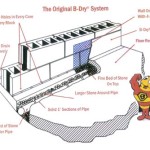How to Get Rid of Large Spiders in Basements: A Focus on Prevention and Control
Discovering large spiders in a basement can be unsettling, especially for those who are sensitive to arachnids or simply prefer a pest-free environment. While the size of spiders found in basements can be amplified by poor lighting and the general atmosphere of the space, it's important to address the issue proactively. Contrary to some cultural depictions, like certain Taiwanese movies that sometimes exaggerate the size and threat level of such creatures for cinematic effect, most common basement spiders are not inherently dangerous. However, their presence can indicate underlying problems within the home, such as moisture issues or other pest infestations that serve as a food source. This article provides practical strategies for effectively managing and eliminating large spiders in basements, emphasizing preventative measures and safe control methods.
It is critical to correctly identify the type of spider inhabiting the basement. While most basement spiders are harmless, a proper identification will allow for the correct and suitable treatment. Common basement spiders include cellar spiders (daddy longlegs), house spiders, and wolf spiders. Occasionally, more dangerous spiders like the brown recluse may find their way into basements, particularly in specific geographic regions. A distinct violin shape on the cephalothorax identifies a brown recluse, requiring extreme caution and potentially, professional pest control intervention.
Understanding spider behavior is crucial to effective control. Spiders are typically drawn to basements for several reasons: the cool, damp environment, the availability of insects to prey on, and the presence of dark, undisturbed spaces. By addressing these underlying factors, homeowners can significantly reduce the spider population. This involves managing moisture levels, sealing potential entry points, and eliminating the spider's food sources.
1. Eliminating Food Sources and Maintaining Cleanliness
Spiders are predators, and their presence in a basement indicates the presence of other insects and arthropods. Therefore, the first step in controlling spider populations is to eliminate their food source. This involves a comprehensive approach to pest control throughout the entire household, not just the basement. Focus on identifying and eradicating common household pests such as ants, cockroaches, flies, and silverfish, as these are prime targets for spiders.
Maintaining cleanliness is paramount. Thoroughly vacuum and sweep the basement regularly to remove spider webs, egg sacs, and any insect debris. Pay particular attention to corners, cracks, and crevices where spiders tend to hide. Decluttering the basement is also essential, as piles of boxes, clothing, or other stored items provide ideal hiding places for both spiders and their prey. Remove any unnecessary items and store the remaining items in airtight containers to prevent insect infestations.
Proper food storage is crucial in preventing insect infestations that attract spiders. Store all food items in airtight containers, both in the kitchen and in the basement if any food storage occurs there. Clean up spills and crumbs immediately, and dispose of garbage regularly in sealed containers. Implement a regular cleaning schedule to prevent the buildup of food debris that attracts pests. This will disrupt the food chain, making the basement less attractive to spiders.
Consider using insecticidal dusts or baits specifically designed for controlling common household pests. Boric acid, diatomaceous earth, and insecticidal baits can be strategically placed in areas where insects are likely to travel, such as along baseboards, under appliances, and in cracks and crevices. Follow the product instructions carefully and use these products responsibly to avoid harm to pets and children. These measures, when implemented consistently, can significantly reduce the spider's food supply, making the basement less hospitable.
2. Sealing Entry Points and Controlling Moisture
Spiders can enter basements through a variety of entry points, including cracks in the foundation, gaps around windows and doors, and openings around pipes and wires. Sealing these entry points is a crucial step in preventing spiders from entering the basement. Inspect the foundation for any cracks or holes and seal them with caulk or expanding foam. Ensure that windows and doors are properly sealed and that weather stripping is intact. Install door sweeps on exterior basement doors to prevent spiders from crawling underneath.
Gaps around pipes and wires that enter the basement should also be sealed with caulk or expanding foam. Use steel wool to stuff larger gaps before applying sealant, as spiders and other pests are less likely to chew through steel wool. Cover any open drains or sump pumps with mesh screens to prevent spiders from entering through these openings. By systematically sealing potential entry points, homeowners can create a physical barrier that significantly reduces the likelihood of spiders entering the basement.
Controlling moisture levels in the basement is also critical, as spiders are attracted to damp environments. Repair any leaks in plumbing or the foundation to eliminate standing water. Use a dehumidifier to reduce humidity levels in the basement, especially during humid months. Ensure that the basement is properly ventilated by opening windows or using fans to circulate air. Proper ventilation helps to dry out the environment and make it less appealing to spiders and other moisture-loving pests.
Consider improving the drainage around the foundation of the house to prevent water from seeping into the basement. Ensure that gutters and downspouts are clean and functioning properly to direct water away from the foundation. Grade the soil around the foundation to slope away from the house, preventing water from pooling near the basement walls. These measures can help to reduce moisture levels in the basement and make it less attractive to spiders.
3. Direct Removal and Repellent Strategies
While preventative measures are essential for long-term spider control, direct removal of spiders is often necessary to address immediate concerns. The simplest and safest method of direct removal is to capture the spider and relocate it outdoors. Use a jar or container to trap the spider and carefully release it away from the house. Avoid crushing spiders, as some species may release a defensive odor or scatter eggs.
Various repellent strategies can also be employed to deter spiders from entering the basement. Natural repellents, such as peppermint oil, can be effective in repelling spiders. Mix a few drops of peppermint oil with water in a spray bottle and spray around the perimeter of the basement, along baseboards, and in corners. Reapply the spray regularly, especially after cleaning. Other essential oils, such as eucalyptus, tea tree, and citrus oils, may also have repellent properties.
Physical barriers, such as sticky traps, can be strategically placed in areas where spiders are likely to travel. Place sticky traps along baseboards, under furniture, and in corners. Check the traps regularly and dispose of them properly when they become full. Sticky traps can also provide valuable information about the types of spiders and other pests that are present in the basement, helping to inform further control measures.
Consider using chemical insecticides as a last resort, especially if other methods have been unsuccessful. Choose insecticides that are specifically labeled for spider control and follow the product instructions carefully. Apply insecticides to cracks, crevices, and other areas where spiders are likely to hide. Use insecticides responsibly and avoid spraying them in areas where children or pets may come into contact with them. For severe infestations or potentially dangerous spider species, it is advisable to consult with a professional pest control service. While the portrayal of spiders in some Taiwanese movies may be exaggerated, a pragmatic and cautious approach to spider control in real-life situations is always recommended.

House Spider Types 10 Of The Most Common Spiders

Spider Identification Guide Pestnet Pest Leads Marketing

House Spider Types 10 Of The Most Common Spiders

Spider Identification Guide Pestnet Pest Leads Marketing

Spider Identification Guide Pestnet Pest Leads Marketing

House Spider Types 10 Of The Most Common Spiders

Spider Identification Guide Pestnet Pest Leads Marketing

Spider Identification Guide Pestnet Pest Leads Marketing

Spider Identification Guide Pestnet Pest Leads Marketing

House Spider Types 10 Of The Most Common Spiders
Related Posts







